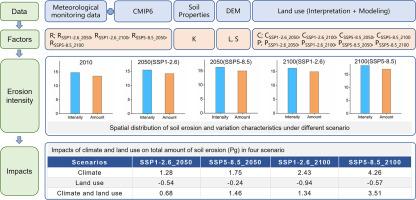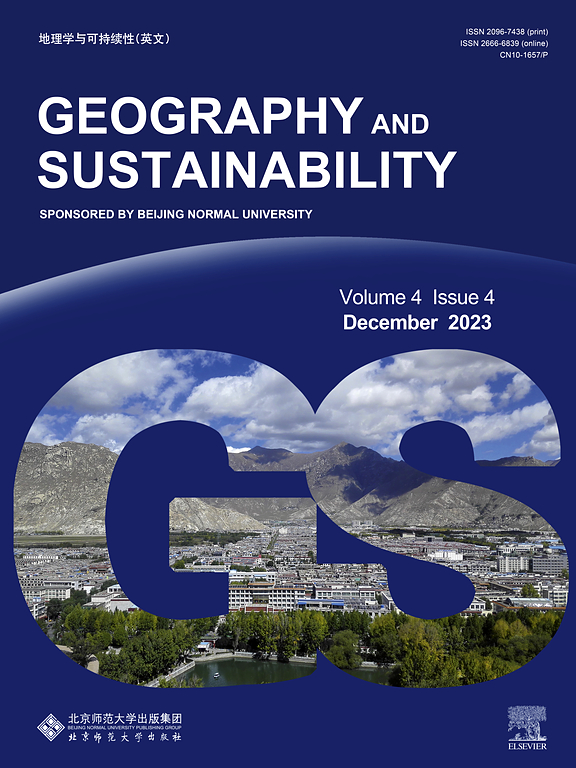中国水土流失现状与中长期变化
IF 8
1区 环境科学与生态学
Q1 GEOGRAPHY, PHYSICAL
引用次数: 0
摘要
土壤侵蚀是造成土壤资源流失和土地退化的主要因素。明确中国土壤侵蚀现状及不同发展路径下未来变化特征,对全球土壤资源管理、粮食安全和生态系统服务具有重要意义。利用修正后的通用土壤流失方程和最新可靠的土壤环境数据,对中国目前和典型的共享社会经济路径和代表性浓度路径(即SSP1-2.6和SSP5-8.5)中长期(2050年和2100年)下的土壤侵蚀进行了表征。目前中国土壤侵蚀的平均速率为14.78 t ha-1 -1,总量约为14.0 Pg -1 -1。在2050_SSP1-2.6、2050_SSP5-8.5、2100_SSP1-2.6和2100_SSP5-8.5情景下,总侵蚀量分别比2010年的基线量增加了5.0%、10.8%、9.9%和25.9%。气候变化和土地利用对侵蚀增加的贡献率分别在9.5% ~ 31.5%和- 6.95% ~ - 1.78%之间,其中气候变化的贡献率约为土地利用贡献率的2.36 ~ 7.54倍。然而,在未来四种情景下,将可耕地变为森林和草地或采取保护性耕作措施可以有效地抵消侵蚀的增加。该研究为中国水土流失治理提供了数据和科学依据,并为保护全球土地资源和制定应对气候和环境变化的政策提供了有益的参考。本文章由计算机程序翻译,如有差异,请以英文原文为准。

Current status and medium- and long-term variation of soil erosion by water in China
Soil erosion is the primary factor causing the loss of soil resources and land degradation. Clarifying the current status of soil erosion in China and the characteristics of future changes under different pathways of development is important to the global management of soil resources, food security, and ecosystem services. We used the revised universal soil loss equation and the most recent and reliable soil and environmental data to characterize soil erosion in China at present and under typical Shared Socioeconomic Pathways and Representative Concentration Pathways (i.e., SSP1–2.6 and SSP5–8.5) in the medium- and long-term future (2050 and 2100). The current average rate of soil erosion in China was 14.78 t ha-1 yr-1, with a total amount of about 14.0 Pg yr-1. The amount of total erosion increased by 5.0 %, 10.8 %, 9.9 %, and 25.9 % for scenarios 2050_SSP1–2.6, 2050_SSP5–8.5, 2100_SSP1–2.6, and 2100_SSP5–8.5, respectively, compared to the baseline amount in 2010. The contribution of climate change and land use to the increase in erosion ranged from 9.5 % to 31.5 % and -6.95 % to -1.78 %, respectively, with the contribution of climate change about 2.36- to 7.54-fold larger than the contribution of land use. Converting arable barren land into forest and grassland or adopting conservation tillage practices for farmland, could nevertheless effectively offset the increase in erosion under the four future scenarios. This study provides data and a scientific basis for managing soil erosion in China and provides a useful reference for conserving global land resources and formulating policies to cope with climatic and environmental changes.
求助全文
通过发布文献求助,成功后即可免费获取论文全文。
去求助
来源期刊

Geography and Sustainability
Social Sciences-Geography, Planning and Development
CiteScore
16.70
自引率
3.10%
发文量
32
审稿时长
41 days
期刊介绍:
Geography and Sustainability serves as a central hub for interdisciplinary research and education aimed at promoting sustainable development from an integrated geography perspective. By bridging natural and human sciences, the journal fosters broader analysis and innovative thinking on global and regional sustainability issues.
Geography and Sustainability welcomes original, high-quality research articles, review articles, short communications, technical comments, perspective articles and editorials on the following themes:
Geographical Processes: Interactions with and between water, soil, atmosphere and the biosphere and their spatio-temporal variations;
Human-Environmental Systems: Interactions between humans and the environment, resilience of socio-ecological systems and vulnerability;
Ecosystem Services and Human Wellbeing: Ecosystem structure, processes, services and their linkages with human wellbeing;
Sustainable Development: Theory, practice and critical challenges in sustainable development.
 求助内容:
求助内容: 应助结果提醒方式:
应助结果提醒方式:


